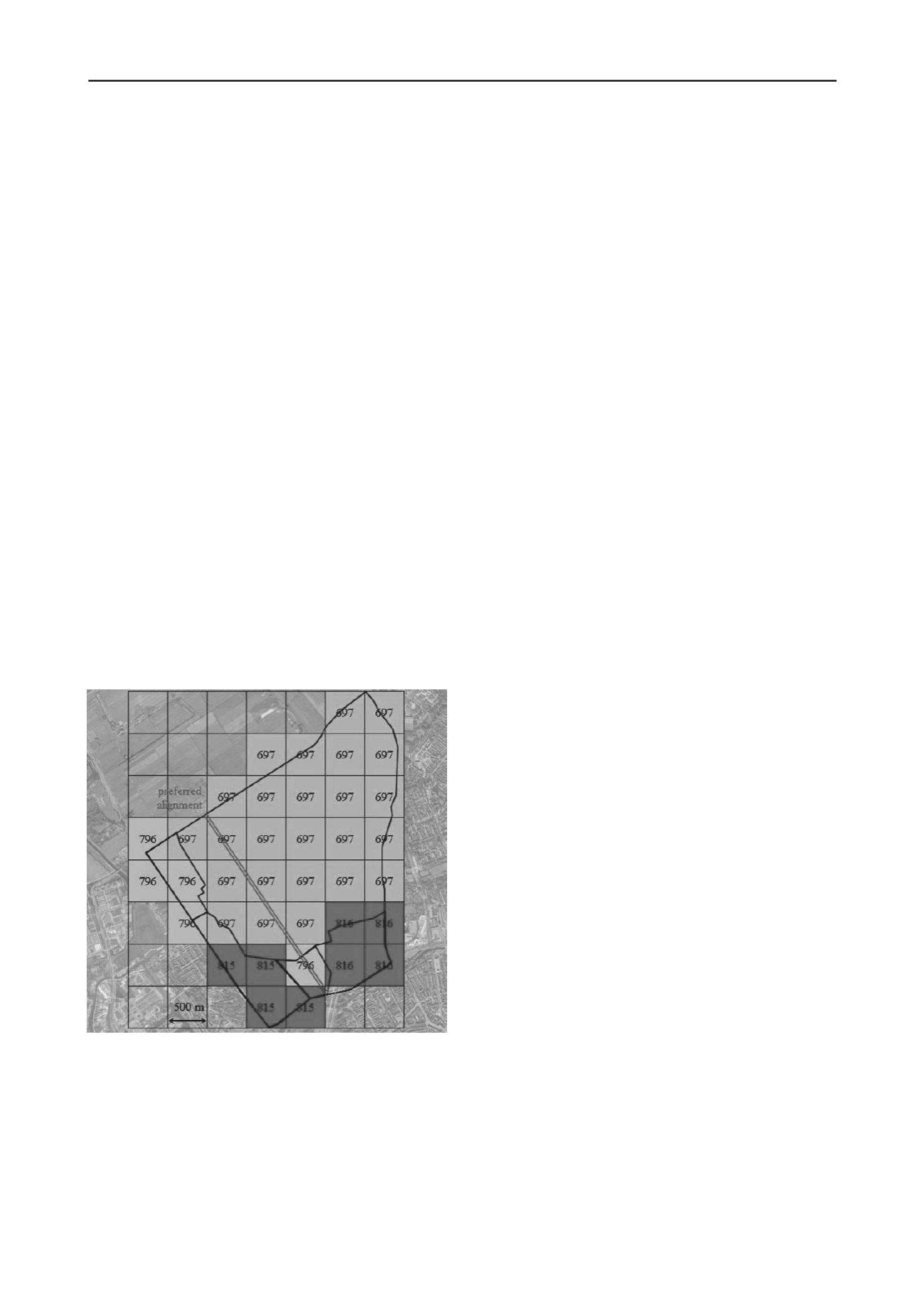
1784
Proceedings of the 18
th
International Conference on Soil Mechanics and Geotechnical Engineering, Paris 2013
The average whole life costs for the traditional method and their
upper limits differ up to 25% between subareas. The average
whole life costs for a 1 year and 2 year surcharge time are more
or less equal. The 90% upper limit is much higher for the 1 year
surcharge time, corresponding to 20 to 30% uncertainty. This
large uncertainty is due to the large uncertainty in maintenance
costs. However, the uncertainty in compression parameters and
consolidation coefficients is the fundamental cause of the
uncertainty in the whole life costs, since maintenance costs are
related to post-construction settlements. The whole life costs for
the piled embankment are much higher than for the traditional
method for this particular case. The difference mainly depends
on the length of the piles and may be smaller in other cases. The
uncertainty in whole life costs of the piled embankment is
limited to 6% and is mainly due to uncertainty in the unit costs
of construction materials.
2.9
Development Phase, second stage
A new data set with CPTs, borings and laboratory data is
obtained for part of area III. The centre-to-centre distance of the
CPTs is approximately 50 m, an increase in data density by a
factor 40. Soil profiles are interpreted directly from CPT
characteristics, and validated with the lithology observed in the
borings. The compression constants determined in laboratory
tests represent a 10% higher compressibility. The consolidation
coefficients are up to 5 times higher compared to the initial
parameter set. The variation coefficient of the new set of
compression parameters is slightly lower at 20%; the variation
in consolidation coefficients varied by a factor 2, as in the initial
parameters set.
Generally, uncertainty in the whole life costs is caused by a
combination of uncertainty in the geotechnical parameters, and
the sensitivity of the construction method to this uncertainty.
The contribution of subsoil heterogeneity to the overall
uncertainty is minor. The effects of variations between
individual soil profiles or CPTs are strongly reduced by
averaging along the road alignment.
2.7
Presentation Phase
The traditional method with 2 years surcharge time is the
preferred construction method, based on the 90% upper limit of
the whole life costs. The costs of 500 m road are visualised on a
500x500 m
2
grid in Figure 4. The figure also shows the location
of the north-south alignment with the lowest costs. The piled
embankment method will be preferred if the time available for
construction is ½ year or 1 year. The traditional method with 1
year surcharge time is not eligible because of the excessive
uncertainty in the costs.
The design calculations are performed as in the earlier
phases, for a surcharge time of 1 year. The settlements are 10%
higher than in the initial calculations, the post-construction
settlements are compatible. However, the uncertainty in the
post-construction settlements was reduced from 0.17 m in the
initial calculations to 0.02 m. This is caused by the significantly
higher consolidation coefficients. Consolidation is completed
well within the surcharge time of 1 year in all soil profiles, with
only a small amount of creep compression occurring after
construction. The favourable parameters also allowed a
reduction of surcharge height from 2.50 m to 1.50 m, thus
reducing construction cost.
The average whole life costs for 500 m road are 523 k€, a
7% cost reduction as compared to the initial calculations for
subarea III. The 90% upper limit is 560 k€, representing an
uncertainty in the whole life costs of 7% only.
Based on these results, the traditional construction method
with 1 year surcharge time is the best option for area III.
3 CONCLUSIONS AND RECOMMENDATIONS
The example shows that application of the ‘Building with the
Subsurface’ concept in a Value Engineering study is successful.
The concept can identify construction methods that fulfil all
requirements, achieve cost savings, and increase the reliability
of cost estimates. The method for subsoil modelling on the basis
of synthetic soil profiles can successfully quantify heterogeneity
using the conventional tools of geotechnical engineers.
The uncertainty in cost estimates mainly depends on
uncertainty in soil parameters and the sensitivity of the
construction method to these uncertainties. The cost estimate
appears to depend less on lithological heterogeneity. A data
density of 10 verticals/km
2
appears to be sufficient to reduce
uncertainty in cost estimates for the traditional construction
method, even though lithological heterogeneity in the
Rotterdam Airport is high.
Value Engineering studies should include at least one target
parameter related to the uncertainty in cost estimates, rather
than focus on average cost only.
A general data set of compression and consolidation
parameters should be established by systematically collecting
laboratory and field observations, to reduce uncertainty in
geotechnical parameters for feasibility studies.
Figure 4. Whole life costs per 500x500 m
2
grid cell and preferred
alignment of road.
2.8
Local site investigation
The project manager decides to perform an additional site
investigation along the alignment shown in figure 4, aiming to
reduce the uncertainty in the whole life costs of the traditional
construction method with 1 year surcharge time. The site
investigation is targeted at reducing the uncertainty in
compression parameters and consolidation coefficient. The
costs of the site investigation campaign are very modest
compared to saving 1 year in construction time.
4 REFERENCES
Baynes F.J, Fookes P.G., Kennedy J.F. 2005. The total engineering
geology approach applied to railways in the Pilbara, Western
Australia.
Bull Eng Geol Environ
64: 67–94
Van Staveren M.Th. 2006. Uncertainty and ground conditions: a risk
management approach. Elsevier Publishers, Oxford.
Venmans A.A.M., Förster U., Hooimeijer R.H. 2005. Integral design of
motorways on soft soil on the basis of whole life costs. Proc. 16th
ICSMFE Osaka. Balkema, Rotterdam
U.S. DoT Federal Highway Administration 2011. Value engineering.
/


